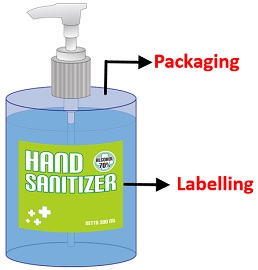 Think of the case when we don’t get the shampoo in bottles or sachets, but in a polythene bag from the retailer, then how irritating it would be for us to transfer it in a jar and store it in the bathroom. In this way, packaging comes into the picture. It is the process of designing as well as developing a package to wrap around or contain the product, so as to ensure protection, ease of use and storage. Companies around the world, spend a good amount in creating the package for the product.
Think of the case when we don’t get the shampoo in bottles or sachets, but in a polythene bag from the retailer, then how irritating it would be for us to transfer it in a jar and store it in the bathroom. In this way, packaging comes into the picture. It is the process of designing as well as developing a package to wrap around or contain the product, so as to ensure protection, ease of use and storage. Companies around the world, spend a good amount in creating the package for the product.
Likewise, think of the case when no information regarding the brand name, grade, description, etc is not given on the product, then how difficult it would be to pick the right product, which suits the need. This is where labelling comes in. It is the process of designing and creating a label for the product. Labelling is part of the packaging, wherein necessary information is provided in the form of a label.
Now let’s move further to understand the difference between packaging and labelling.
Content: Packaging Vs Labelling
Comparison Chart
| Basis for Comparison | Packaging | Labelling |
|---|---|---|
| Meaning | Packaging is the process of packing the goods in the appropriate package, be it a jar, tin, bottle, box, packet, etc. to sell the product conveniently to the consumer. | Labelling can be understood as anything from a written text to an image, from a barcode to a symbol, which is affixed on the package or on the product itself. |
| What is it? | A component of the total product personality. | Part and parcel of the package. |
| Describes | How does the product look? | What is inscribed on the product or its package? |
| Objective | To provide protection and act as a 5-second sales commercial. | To provide complete information about the product which can influence consumer's buying decision. |
| Design | Appealing | Formal |
Definition of Packaging
Packaging can be understood as the range of activities associated with the designing and manufacturing of an appropriate package, i.e. container or wrapper for the product, which is used to protect, transport, promote, store and identify the product.
Packaging often reduces the risk of breakage, leakage, contamination, and spoilage during transit and storage.
For example, Soap comes in a cardboard box, coconut oil comes in a plastic bottle, facewash comes in a tube, while chocolate comes in a wrapper.
Components of Package
- Physical Container: Plastic, Metal, Glass, Cardboard or Wooden box, or cellophane, cloth wrapper, paper bag, polythene bag, styrofoam, etc.
- Label: Label carries the product’s brand name, logo, ingredients, inventory codes, instructions for use, etc.
- Inserts: How to use and Safety Information, Booklets, Coupons, etc.
Packaging Industry
Packaging Industry is divided into two sectors:
- One who prepares packaging material and
- One who transforms these materials into packages.
As far as the packaging of the product is concerned, good packaging indicates the quality of the product, which is not related to the value of the product. It is a promotional tool, which tends to convey the messages from marketer to the final consumer.
Levels of Packaging
There are three levels of packaging:
- Primary Packaging: It is the packaging which is in direct contact with the product, as it carries the product and remains with the product until it is consumed like tetra pack, can, PET bottle, jar, etc. As you can see in the above example of toothpaste, the tube contains the paste, so the tube is said to be the primary packaging.
- Secondary Packaging: An additional layer of packaging provided to the product so as to avoid breakage, or to protect it from external damage, which is called as secondary packaging. Further, the consumer usually trashes this packaging. In our example, the cardboard box which contains the toothpaste is the secondary packaging.
- Transportation Packaging: It is the third layer of packaging, commonly used when the goods are transported from one location to another. This packaging not just provides protection, to the product from any damage, spoilage or breakage, but it also makes it convenient to transport the items in bulk.
Obviously, it is not easier for any manufacturer to transport individual product, so they are packaged in cartons and then loaded in ships or trucks, to supply it in various locations. So, corrugated boxes are used for this purpose.
Also Read: Difference Between Packing and Packaging
Definition of Labelling
Labelling is mainly used to provide all the relevant information about the product to the customer such as quality, quantity, features, price, product name, producer name, contents of the product, batch number, manufacturing and expiry date, instructions for use, storage and disposal, legally mandated information, quantity, weight, barcode, etc.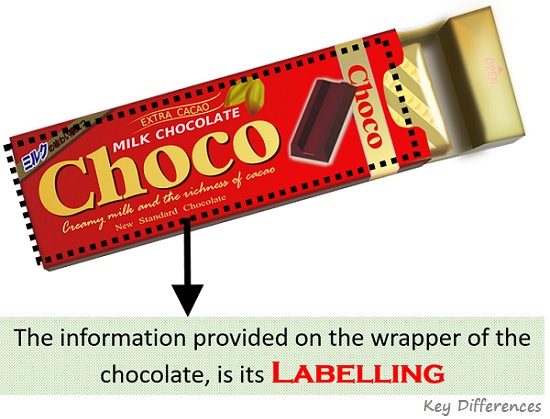
How troublesome it would be for a manufacturer if he/she has to communicate each and every single detail about the product to all the customers. In this way, labels are of great help for them to inform the customers about the product.
There are many countries in the world, wherein labelling is compulsory, as well as they have certain specifications for labelling.
So, even if the manufacturer wants a simple label, the law makes it compulsory to add specific information on the label. Besides this, labelling also plays a crucial role in highlighting the quality or standard of the products, for instance, you might have seen the labels like ISO 9000, vegetarian and non-vegetarian marks, ISI mark, Hallmark, BEE Star Rating, etc.
In simple words, all the activities associated with designing and producing label, to be attached to the package or the product, comes under labelling.
What is Label?
The label is nothing but a carrier of information, which provides complete details about the product and the seller in written format, to the final consumer. Labels are slip or sticker affixed on the package or sometimes directly on the product. It can be classified as:
- Brand label
- Grade Label
- Descriptive Label
- Informative Label
Also Read: Difference Between Branding and Packaging
Key Differences Between Packaging and Labelling
The points discussed below will help you in understanding the difference between packaging and labelling:
- By packaging, we mean a science, art and technology of designing and creating an appropriate package for the product so as to make it ready for transportation, storage and sale. On the other hand, labelling means any printed text, symbol, design, etc. affixed on the package or on the product, with an aim of informing the customers.
- The packaging is one of the major components of the complete product personality. However, labelling is an essential component of packaging.
- Packaging focuses on the appearance of the product, i.e. it is more about the look and feel of the product. As against, labelling is mainly concerned with product description to be given. It determines what is to be displayed on the product or its package.
- The objective of packaging is to provide protection, to facilitate storage and transportation, and to promote the product. Conversely, the main objective of labelling is to give a brief description of the product to the customers, as well as to promote the product.
- When it comes to design, the design of the labelling is usually simple and formal, which is meant for clear communication of the message to the consumer. In contrast, Packaging is by far one of the major tools of marketing, hence it plays a significant role in building a brand image. Creative, innovative and visually appealing designs for packaging are preferred, which attracts the customers.
Functions of Packaging
The functions of packaging are discussed as under: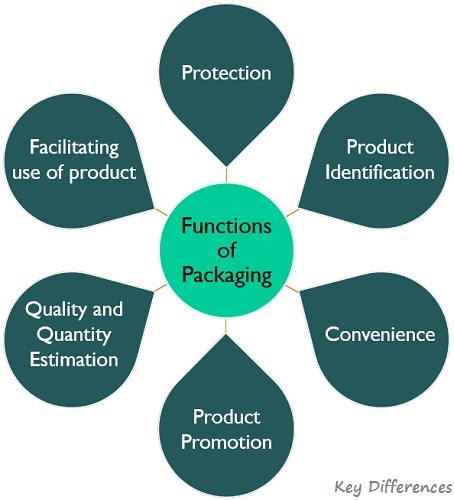
- Protection: As we have already discussed, the basic function performed by packaging is protection. Now you must be wondering, protection from what? So, it provides protection against sun, rain, moisture, breakage, tampering, contamination, damage, insect, etc.For example, You might have observed that snacks like chips, wafers, biscuits, etc. always comes in airtight packets, but why? Because these get spoiled when they come in contact with the atmosphere.
- Product Identification: One more function performed by the packaging is that it helps in identification, i.e. the manufacturer of the product, and distinguish between different products in the market.For example, one can easily recognize a yellow packet of noodles, that it is Maggi, even from a distance.
- Convenience: Product packaging is not just helpful in protection, but it also makes it convenient for the sellers to move the product from one place to another, as well as to store it in warehouses. Moreover, it is also convenient for the users to put the product in racks or shelves when they bring it home and use it when required.For example, Crockery items like plates, glasses, bowls and coffee mugs are fragile, so they can be broken easily. That is why packaged in cardboard boxes.
- Product Promotion: With the emergence of self-service retail stores, now manufacturers are bound to sell the product in attractive packages, as it helps in gaining the attention of the customers towards the product. It would not be wrong to say that packaging acts as a silent salesman, especially in departmental stores. Creative and innovative packaging often attracts consumers and increases the sale.For example Masala’s like Kitchen King Masala or Shahi Paneer Masala, often use the images of a bowl with Shahi Paneer, so as to act as a five-second commercial, and attract the customers to pick it.
- Quality and Quantity Estimation: Packaging often helps in guessing the quality and quantity of the product. With the type of packaging, one can easily determine its quality, even without using the product. Similarly, with the size of the packet, it is easier to recognize the quantity.For example, A product of 500 grams is smaller in comparison to a product of 1 kg
- Facilitating the use of the product: Packaging also helps in comfortably using the product without much labour and difficulty. Nowadays, innovative packaging is used which makes is easy for consumers to use the product without any struggle.For example Products like sanitizers, body lotions, hand washes are packaged in pump bottles, so as to make it convenient for the consumers, to use.
Functions of Labelling
The basic functions of labelling are given hereunder: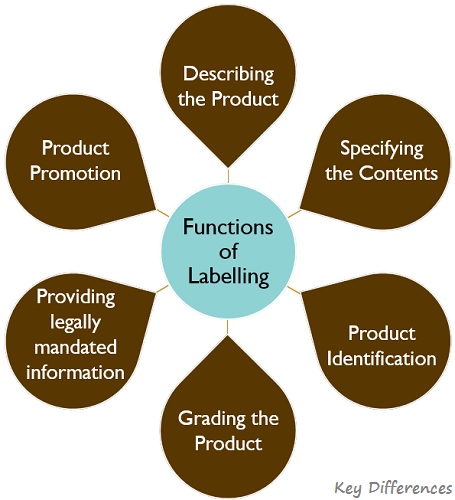
- Describing the Product: Labels help in describing the product as to which variant of the product is for which category of people, be it age, gender, type, etc. It also states the weight, price, directions for use and other related information, as well as it gives the reason to purchase.For example, Baby Diaper brands like Pampers, Huggies, Mamy Poko Pants, etc. indicates the weight of the baby so that the parents can select the diaper accordingly.
- Specifying the content: With the help of labelling, the manufacturer also provides the information about the ingredients which are used in the product, so that the customer can read it themselves and decide if they want to buy that product or not. It increases customer loyalty towards the brand.For Example, You might have seen the label Paraben-free or free from harmful chemicals at the face of the skincare products, while mentioning the main ingredients at the backside.
- Product Identification: Labels are of great help in identifying the same product offered by different brands.For Example: Suppose if there were no labels on soft drink brands, would you be able to differentiate between Pepsi, Coca Cola and Thumbs up? Obviously no, because by way of labels we can easily identify the brand selling the product.
- Grading of Product: Under one umbrella brand, a company adds a range of products, as well as different variants of the same products. Labelling helps in classifying different variants.For example: Under the brand name Horlicks, two variants are available for children Classic Malt and Chocolate Delight. Further, women’s Horlicks is also one of the variant added under the same brand name.
- Providing legally mandated information: Labels are also important in providing legally mandated basic information such as Batch No. Manufacturing Date, Expiry Date, Weight, MRP, etc. Statutory Warnings also forms part of legal information, which is provided by way of Labels.For example: ‘Smoking is injurious to health’, a statutory warning written on the packet of cigarettes.
- Product Promotion: Labels also sometimes help in promoting the product, i.e. colourful and interesting labels often grab the attention of the consumers.For example Vibrant colours and images of cartoon characters used in the kid’s products, to encourage them for buying.
Conclusion
Both packaging and labelling acts as a tool of marketing which when used wisely, stimulates the customer to pick the product off the shelf.
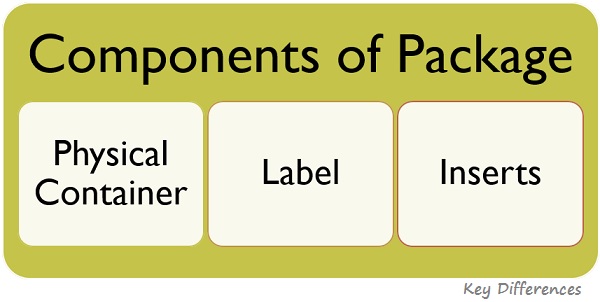






MILLOT3716 says
Thank you!!1
mesfin says
thanks